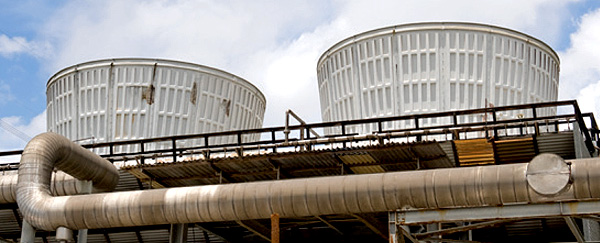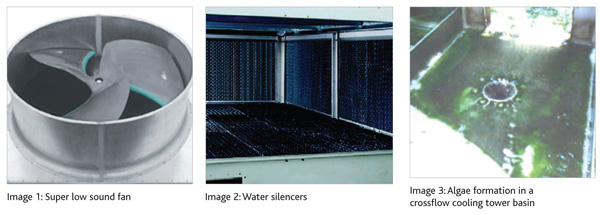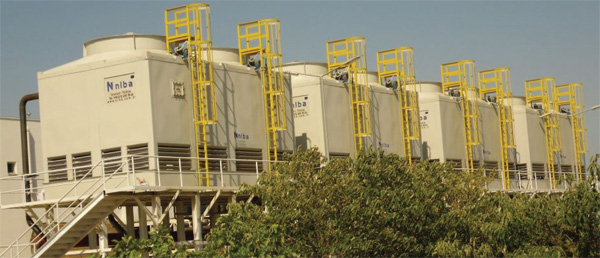Cooling towers have gained in popularity and have become the standard heat rejection method, says Georges Hoeterickx, and gives several pointers to be kept in mind while choosing packaged-type cooling towers.
Cooling towers have gained in popularity and have become the standard heat rejection method, says Georges Hoeterickx, and gives several pointers to be kept in mind while choosing packaged-type cooling towers.

Cooling towers allow designing of cost-effective systems with maximum system efficiencies. The aim of this article is to provide an overview of a few important criteria that need to be applied when selecting or specifying a cooling tower for a project. The scope of this article, however, is to focus on packaged-type of cooling towers and not field-erected cooling towers. Packaged-type cooling towers generally go from 100 tonnes up to 1,200 tonnes capacity per single cell.
DESIGN CRITERIA OF A COOLING TOWER – APPROACH
The size of a cooling tower depends on the flow, water inlet and outlet temperatures and the design wet bulb temperature. The difference between the water outlet temperature and the wet bulb temperature is called the approach. The smaller the approach, the larger the size of the tower. Cost-effective selections are based on a criterion using an approach of 4°C. A criterion using an approach smaller than 2.8°C is not economical, nor will it be certified by CTI. Selections using approaches more than 4°C result in higher condensing temperatures (reduced chiller efficiency and performance) without much savings on the cooling tower.
PERFORMANCE – CTI CERTIFICATION
While it is not easy for an expert to compare different cooling towers with regard to performance and confirm which one is correctly sized, the task will be even more challenging for non-experts. It is, therefore, strongly recommended to limit the choice of the cooling towers to those which are CTI-certified (Cooling Technology Institute). CTI is an independent organisation, which is well recognised around the world, and most global cooling tower manufacturers have their cooling tower ratings verified and confirmed by CTI as part of the CTI Certification programme. Selecting such cooling towers assures that you will receive the specified performance as well as fair play between all the different equipment manufactures.
Products which are undersized are still a common practice, and the final owner/user pays the penalty for the undersized cooling tower by having his system running at higher condensing temperatures, and as such lower efficiencies. Some manufactures do have certified products, but do not hesitate to offer non-certified products, too. It is, therefore, advisable to go to the CTI website (www.cti.org/cooling tower certification) to find the list of all cooling tower manufacturers and their respective certified products and models and make sure that you receive what you expect. In case of doubt, one can always contact CTI.
INTERNATIONAL BUILDING CODE
The International Building Code (IBC) is a comprehensive set of regulations addressing both the structural design and the installation requirements for building systems, including HVAC equipment. Compared to previous building codes that considered only the building structure and component anchorage, the requirements contained within the IBC address anchorage, structural integrity and operational capability of a component, following either a seismic or wind load event. Simply stated, the IBC code provisions require that the cooling towers and all other equipment permanently installed on a structure must be designed to meet the same seismic and wind load forces as the building they are attached.
Cooling towers should be certified by an independent approval agency to confirm they meet specified design conditions such as wind load and seismic forces. A common value for the wind forces used in the region is 2.8 kN/sqm or 110 km per hour wind velocity.
AXIAL OR CENTRIFUGAL FAN-TYPE COOLING TOWER
There are two types of cooling towers available – forced draft, using centrifugal fans and induced draft, using axial fans. The major advantages of the axial type fans are:
Considering the benefits, induced draft axial fan-type cooling towers should always be the first choice. The only reasons why centrifugal fan-type units can or should be considered are applications where the cooling towers are installed inside the building and the fans need to handle an extra static pressure or when extreme low sound levels need to be achieved.
It is important to note that thanks to modern fan technology developments, axial fan units can be made available that meet very stringent sound criteria without being penalised on the power consumption of the centrifugal fan units.
The image, right, shows a typical super low sound fan. Such fans reduce cooling tower noise levels with nine to 15 dB(A). Further noise reductions can be achieved by installing water silencers (see Image 2) to eliminate the noise of the falling water.
KW FAN VERSUS TONNE HEAT REJECTION
When designing or selecting a cooling tower, one can minimise the first cost of the cooling tower and end up with a tower having high power consumption. In this regard, it needs to be noted that for example, two years ago, Kuwait’s Ministry of Electricity and Water issued a Code of Practice to be followed in order to rationalise the power consumption in buildings. For cooling towers they specify that the maximum power rating of the fan motors should not exceed 0.04 kW per tonne heat rejection. With designs available today, this target is relatively easy to achieve, even with CTI-certified products. However, there are manufactures who continue to offer lower cost axial fan models, which result in power consumption requiring 30% more fan power than a more efficient solution. Over a period of 10 years, this represents a significant amount of kWH and electricity cost.

TYPE OF CONFIGURATION – CROSSFLOW VERSUS COUNTERFLOW
The old style crossflow-type cooling towers are increasingly getting replaced by the more efficient and user-friendly counterflow-type cooling towers. This type is already the standard at all Middle East district cooling plants, and is now more and more used as a packaged tower.
Major reasons opting for a counterflow-type cooling tower are:

HOW TO KEEP YOUR COOLING TOWER SAFE AND EFFICIENT
The above is the title of a guideline published by Eurovent a few years ago, and describes the required measures to be taken to ensure that a cooling tower operates safely and efficiently. However, it is more focused on the prevention of the development and spread of Legionella (LD) Bacteria.
A few of the major requirements for a cooling tower to minimise or avoid the development of LD bacteria in a cooling tower are as follows:
When considering these important criteria it is obvious that the old style crossflow tower no longer meets any of these requirements, and high level designs have increasingly moved towards counterflow-type of cooling towers.
Crossflow towers have sunlight directly shining into the basin. The direct sunlight combined with the warm cooling tower water results in a strong formation of algae in the basin, increasing maintenance and water treatment costs. The result is shown in Image 3.
The area beneath the fill in a crossflow cooling tower is nearly impossible to inspect or access. Dirt will easily accumulate, also because of the low water velocities in this area, which will enhance the possibility for LD contamination of the cooling tower water.
Drift losses in crossflow towers are five times higher compared to counterflow, where Eurovent-certified values of 0.001% can easily be achieved. Besides the higher water losses with crossflow type of towers, the potential spread of contaminated droplets from a crossflow tower is five times higher, as with the modern counterflow cooling towers.
CONSTRUCTION MATERIALS
Cooling towers are made of different kinds of materials, such as galvanised steel, stainless steel or Fiberglass Reinforced Plastics (FRP) or a combination of these.
Considering the harsh conditions cooling towers have to operate in the region, galvanised steel, at times protected with some kind of coating, is a questionable practice, especially for the water basin components. Stainless steel offers an excellent alternative to this, and customers have the choice between SST 304 L or 316 L type. The 316 L type is more expensive but offers better corrosion resistance in high chloride environments.
The use of FRP should be handled with great caution for several reasons:
ORIGIN OF MANUFACTURING
It is advisable to know where the cooling tower is being made – at the manufacturer’s premises or outsourced to foreign subcontractors. In the latter case, assurance will probably be needed about the final quality and after-sales support, especially with regard to spare parts and replacements.
Often, cooling towers are shipped unassembled to jobsites and, then, assembled by a local labour force. In such a situation, never expect the same quality as you would get from a cooling tower assembled in the manufacturer’s own plant by skilled workers in factory conditions. When it comes to the practice used by some suppliers of outsourcing the complete manufacturing of cooling towers, it needs to be remembered that the savings made in shipping cost don’t offset the expenses and problems clients normally experience later, with units assembled on the jobsite by unskilled labourers in difficult conditions.
SUMMARY AND CONCLUSION
Selection of the right cooling tower for your application can be summarised as follows:
The writer is Director Business Development, Evapco Europe. He can be contacted at: hoeterickx_g@evapco.be
Copyright © 2006-2025 - CPI Industry. All rights reserved.